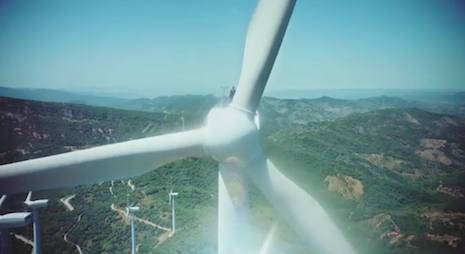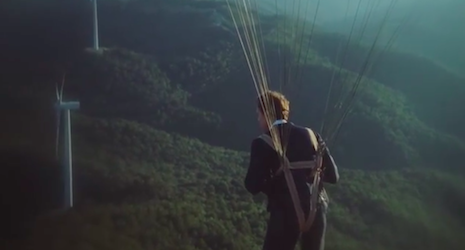LVMH-owned Loro Piana has debuted a multifaceted campaign centered around its new eco-friendly fabric treatment that makes its clothing resistant to weather with minimal environmental impact.
Loro Piana's new Green Storm System process is an update of the brand’s classic Storm System that makes its textiles resistant to wind and water. A video campaign accompanies the new fabric, highlighting the connection between product, people and nature.
Green Storm System
As climate change and other environmental issues become more of a priority each year, luxury brands have been increasingly adopting environmentally friendly manufacturing processes to do their part.
The latest of these efforts comes from Italy's Loro Piana, which has introduced a new and more eco-friendly version of its popular Storm System fabrics, which are fabrics treated to resist inclement weather.
Loro Piana is debuting the new Green Storm System, which revises the process to decrease the apparel brand's carbon footprint, use less resources and still provide the same level of quality.
The main fabrics being treated with this new process are Loro Piana’s Tasmanian wool. The wool is named for the island of the same name off Australia, from which the material originates.

A still from the Loro Piana campaign. Image credit: Loro Piana
Since then, Tasmanian wool has come to signify any type of lightweight, breathable wool in Italy.
Loro Piana has released an accompanying short film to promote the new process and a new collection of clothing made from Green Storm System-treated Tasmanian wool.
The short film features a man wearing a Loro Piana double-breasted suit made from the material as he parachutes down from a wind turbine.
The theme of wind permeates the video, as the man gently floats through the air, his hair only lightly tousled by the breeze.
The ease with which he navigates the windy terrain of a wind power plant emphasizes the fabric’s ability to withstand negative weather conditions. This durability is a trait that Loro Piana has prided itself on for years and is a major part of its branding strategy.
Sustainable efforts
All around the fashion industry, efforts towards sustainability are growing. Examples can be drawn from many different companies.
Italian apparel and accessories label Salvatore Ferragamo, for example, has taken great steps to become a sustainable company and reduce its negative effects on the environment.
Ferragamo released its Sustainability Report 2016, which is showing a 10.8 percent decrease in its natural gas consumption in one year from 2015. Also, Ferragamo's Italy-based employees traveled more than 9,542 kilometers, or 5,929 miles, carpooling (see story).

Tasmanion wool. Image credit: Loro Piana
Elsewhere, Yoox Net-A-Porter Group ceased all production and selling of products with animal fur in them.
The new policy, which impacts Net-A-Porter, Mr Porter, Yoox and The Outnet, will also include partnerships with organizations including The Humane Society of the United States (HSUS), Humane Society International (HSI) and Lega Anti Vivisezione (LAV). Sustainability is becoming more imperative for retailers as consumers seek brands whose values reflect their own (see story).
Loro Piana is in good company as it makes its popular Storm System feature even more environmentally friendly. Other fashion brands are likely to follow suit and embrace their own paths toward a more sustainable business model.
{"ct":"qt\/IEO28HBMrKjQxBE+vPH0eWedsEj09Udjl4k9BJpsgv6TESiPP90Y9nrY3DlDELpNtUCJnE\/zZEheBQMcpCaGiInSzB4hG8A4haHWEHf\/A3ICN6pZaDBi8pZ7h1ZSr8QUKVlyPc0cwWamF93ewXc6IZbC8a4KIFt3T4MTctRvIcRuzx9a2XboE97oz4MBCJjeGA+S8Xo\/QbM1ouzb1xJ1yv5\/lkLfxMv9ms63YFUH2o06Y\/ecdPai7BFs\/VC+3BjdRAueyac2JPs\/Dis6APXFpN9otKQloLY7DBL0HZeNCj9H730Yy8blHbVO6sot+dibczS6sB2ZgJ9JPNi8hC+ZOcMr\/R9cd5gv3pOBseZxmLNPWDbFUr5iEgGiMNvcg48reOKcW2\/Zz4IMxS2Lp65Md6KDVUyHu7Es4xZux9rYMRyce935iMEaB+zLY2mRq\/Z6nGLAjytMlxvcjTBaGDZZZk7gyTaZawmaYXArDP4S1c4neA4z8+adUA+rcBsz8Br\/85v0AiYcqCYNp4xwr2b9QJ\/lcJKCF9\/3bECIfW2wg3SAkDbj6mb8w9UfGj5rm+DPI7JXVGkk\/0Ute2MAvgmI8FQUUjoI9ycxAL54JOW+K1NZ\/g0SoJwqHr7Zis7qAd4+f35BdvqRuKzRe2ES\/mZi1Xa+a\/BG5XmJ1hKolB\/8KCZkyZv1MFJ5ZDtnwOnWnGSRWd2lmXDpstAmD4nW7u45bjR0NTfrb8Ucl8xLGEjufNaOvkWcMxMSQa\/JQYwWEDB\/NAz7h0vQLl\/JWiQQRpXyjQjHGd2AUNp0O8sG52QPel\/DE\/yVO5FpeVlErszB3MwrNUlTetC7\/rICV3pUYT+aqobwu2NhGxUXomXW9YurKG2rFS65MhKyy0VrdBlXU3Df6SPB8Mdw3q1jw4YFDtoWmxmRwl5unqXGennAkmbW8JcX9vE2YCg+\/bwgoPmPpMRl30lNjegFkO6ujmA1+f11nUV2GvvM568fdXgmAEb\/BG+uJbe7iIp0SCt5pYuNxR9dWWHzKU9\/hxZWPyoLmDONKVCfpazO6Zo9HG2Qf14jwKObbtyO1iPRaPHUjQg36Q+FozhjQ4pzVNuShynUxzHSSAbc8ccTuaDZ7jV1aBiyxCXo4CoiQ6WXR7wZzjz7PF4CsNVig2SuvlnLdzj2zT71mwCn+zzk1Snhw4umh4B12oLisCIzaRNQCd02rLOtCDQ0YC6X1r0TNx9r9owxiPx3ud2+ZGdRzOftP0nFm9tBK+fBGcDgR1k\/qDkuckVhgDPr16peI383siq2HBQ9g7n8tTWdv3+G72FdEf52As2r\/fj6zsx8QFjmfZfQHaSpg4NHxWFogf6nyavdP6ldkQB1PVoXWefw6\/YD5FmxPCacXsBhfGZaxZk6iGuwh+O0aefvd5UrPIsR9YsHxC\/p\/WZNVuaRfn\/xUK8NloUTXZbev2bHSVDDv0SjdT5tsQOs73IwwfJiaAjKC5azJtvOxkuuGAYo6CFRq4cxLJM4y26hTWEtn95pUZTfWoVhLK\/vdo9ywOB0RJsDYlr53jM2iy2g6KU6CD4vs2HaV\/08US6bEPu7ONhpu0qt51XkC3Z02SRXOv9lcjHgJhNJuWjh62NIvphZ107vremZgm1ubMjTLlHdOSl1tkckhWI8y8aIEHOIXj73YWInrbXAOfU+r1tEBYMqe65xFhGaDvI6rieCNYdw3sqiKREQCX8CfKnCkSdZV4b4asUes1bEsCczYNvdtUx9aMGMeM8Qbi0+rWczRIfisKFYazxM97jBjSGDprFUTHvtKLfNpqc76g1FCsuJMqsKebp0sk4DcTsSF83vyLBjg6JgXSQU3WTy07UTUq2eCWw3JdlkoSQjyewhCO2k0FXv8pb\/O+11WpOOKVgKBQ44i+wU9yrOdVnqu2IzBN9EdPYzEKMa+6dSB34FvaJ2Ws+3tQuV4qjPKqCJra0BMiJzYRLjn5Ce7txSlFg2aRTkSu3RDqGSjJXf\/uGnsuR+05PsVDt80riVBnLQM64xvqise29tS5uWatLC+9qBRh7fZ4TEXxEhuW3MNBi7TFTYpRcne8i9FTwTc3Gm8lF\/7fpbCoBgBj64ZL3+LKBPc83dqI0PTfpTD1obnxVNQPh29IcnhntNMl0Vo1CIsHnxNOq+SsquLXatSMI0ZjAZeR9+S3gsdFBCKY5ZqpWTePmPnESvLIHW5DlXvNl\/Am7V23evFpE6dyGhB4htgpSXj5aVLpACFfXRNQCNrxBrpP3pecMItKUNxto8GXahzYfioRloTuvr9nL\/E15DB5DTsVeR\/jdgKSV+pFd3vm\/k2lh5nKqu+YyEcLSR+cTh+1\/mALoCWwy4MK+cqlm2pSn+c+kKAyv5ejygoQK6bqa8ICxkjCok1RQOBc2TQB2Q39qV2E6zu17iTnoZJsxd0eNGN95nec8nk0ihecrTjQalAX7tpINgZeJ\/XAqvh9Pp68WawlxSCJGPpq\/o5u09tevxSBdF45Yhw+Xp\/1+XGijYKLFdh+s1i9pUXpjxlE9Ilw\/JzCftCO5utFzAGN6Yo0kksX8fEPA87nH0JmSaFLZeADKvj04E8Qf+fTptjj8hWvP0OZs\/hswX16y8OtQSh7dPXsipVizUQn2n93PJCZqS\/BvbXguwYEKzJBNOvcWMzZH1Ug3RyP4sbmgE4bvsxVViw1jahTaOPo+s5lECq09Qpbf8EbLeoQpEkV5Lysd2640ntwGtETe8HZxDcRRLWDFyFe6fRjg186S0TSwx\/YSYCOBguAnWQifousdryUqtj0ixCTO1dMbGckrapUVPa+q1+ARSyIXfMDEVgoUFqis47l0pHPYLOWPL\/0\/LB6dBebYYIzMkFGIUMSHEYJy7h8OI3iFay6KdYF0QGD8fSvwHwOyygXbCqSVLPZFCwqzb0TPNtrr9Yjp7X4F5pQl4m3DdD5frC9GDiboDtdv2CvQynJWVOs26JN4jqwKHZwfq7886aUXaasTga\/2DwZqsh0EwwLpOCtTA12XrJzXnYcI0ixRrFrV+2pJbQuMU3eroc0PMVSI+BSc22osU9vWdPAUKk66+zpNQ2aZIoeJppGwNajqcUvxoFMv1SzTE57tbHTGrW2tl4\/BBRuCAwGoL9EK53migOsoY8DkT76uDsJOqPFBvcwbO65w\/wUPH6jGwYhqAWux3LLNp3Df0L9tE7ISMKp+5sa0mlc+xu8CYwjmOB7ywSpHgv9Ptr+yBfbvjDG8OdSnJG60PaXRqQzKAwIR01gE0x5krEyye3KvapGaPuaH18jTx1XJsnpwOylfCjqfQRIuJWMXxvLzX2eGiYBUMV8DJInAyDx8BrC6wmn9ReiflGOupCXzqO0OCJfbs9b7fYiajctRManGMbbekHPlSEkBz7mIT6Wi767esQzn4B1PO5ZjuMIpuBEUDs3v4yAuo+i0kxJRnR7OrqLG+zEHQqU2l+lwSkf\/QluqeZehyUubifaw8Ors+zzr91iESCZXcsv3fmYgggOgkf1Gy5DYxOk+RZl6OpTu7\/v6ROJN2MSFX1Vj8HjUwLZgHiCyhFyny\/s9yZEUtCV+RFwubTOJdY5bvHGrLCioGSPrg\/YsmcmcA53PYJHQAmvGnNLhKRoeAd8ml33pDHkD\/TiBOmN1W4YXi54x3tRGbYiNJJ9Meratj50K9qCA+NJN5m\/hqeQBdhsohYyVuxdb5LkT+AILU\/HgFr8IvGXSs+nojpsrqCG7DoUtmzg1dLWDVBEOwqa7SO1NNTUoupcQa66hrjn1FLVaIH6n+lRXv+IWQvqKVb\/xZUD+OT5bWczIHuNDxdQAd2MQz3TgnCiqGx+VfpLyU8WiXB3WS3N3ZktQbe5PurJJe+xk2H6SmDg6gmK0Sjzhk5PiogzOKUIxlrKHHzirKRv1LKmWhD07bfXAF+FpDb+b0MN\/QKhMMyT4R4jE\/i+Bz\/I7FTLJKcUrideZNON1dMiSZmJtyzCt4LDV0IPv8toiOy9WL8s0rg\/L935o1K6iBQ3ODIHc4+hSPyub0ko0wpFsswNvR1kyhhBksgmZIAcpUDbLQ0ENxmP\/nDBOMkDECzz\/FFIjBLQZETw5KjsnFUdiN1PoM+iJ28X0dALNvXzuDDl88f0ddVr1UGuGMAVqvbvfZabPQxFvzW8yUJihpoc1d10HH3xRdR2X19UVgu+fJ0Ww00I9vyBhWWfoEGJo\/\/ciaCvbH8h0Eehi3NuMwAiovQMNsc17smvBX1Wm8yPBLZ2FplmFgm32gdoP+j0B0nA+Ha9EAi2tCe\/rVDN\/T+sNU4mPgwNPZeP7oaHVx9\/A1BXCEy4ubvZ8DB5RXDnhbmNeGGNbhIPYjC9nmpmLss8\/0bLIl64vc1xpXlovLFxPEup9YFvPe8bj7Ge1xNHSe8E21YcatMfriajtkUxk3XDzYMQep0FQ9ysL1M3+z4vJpU679+Q7rDQLA6AxpkTZOH0ZY6xGM4jDT7csO2vbpXFWvud7lmH\/PmVZvZC\/45c\/KKAnMVsc+Iio3pxE9WhtY2FSyHLByG8ZOipdnIbye9jfPjOweJ78XV7LfniOxf8QPx4AF+48vsNf2OXRFdrBTpalCkOi6KbjuUH+DL5CnsP5QCXfD\/sRtgnKyEr4qgCx0AD6eT7RsAa70cYUyy29l9W\/5Dio6GmPq4Mhk9084y7gJAdZxYErzR744vj7ou1PybB+O3qvSdoL\/OyIiWjsgHQBSvnHCpTCaQW44sLRrwa5ejoOJkNORR5wMFctcQOfxNguxPP2WiYIXaplhQJ3Dn4wOVkO+mOtaZFCWtQs9VLPfcgzrzppL5GTC5ZVChKaEl7Gx3wh\/+Lm1UTfSrDp6iP1Gik\/cVDK40KF20RXjHYl4lBVRPXL8STab2ulhbtFfcu8t3eSxGEIvs+y\/1xZXcTKdaN9AmwbUgvdHUr9J3x++GYMH8W2surhSshSZtUV4mgtsw1dad+XpdsvnKe8CdfJuH8+iW\/DXGuIl5E5kvWTdlGdXGlKh6NSaHiZGRJn6gelhTX8FMRVAqZIZG1P2AMxXj4GAYHfQaNfB9BDsULIMNCxP0dIEyIMA\/0M8mQkNsRe3+cPErEMaw61aCbGS7HBZYHi+vjJ1pr03i2vavrGMVhnT3S8irAe64kAnbPWfozjemDGZ84yakR9ugL59JgjYajXF+V89heMieu+dL9lCePfI2GWJ+sRcS75fMnNAWMMzKlbV0UHQPSb6XQbORMkq\/1vXLq6aU5JxRd21OaTS1TXlx5i0I9FutkjpKrLRp199hVM+qQ\/MG8\/JYUbEUQ15AODkif1HfNSpOZ2MWQU+ir2wD1VE1vENQpZmNiG+fMCpISHIgNSqCMj0InxmeyADD33DKLs6ACkchCIaSiKsdaDAzaESbVybYmMXgj\/xHvx9cRC1cVLHDNj8gHf6EWNs7mkz0GGWyq5+XQoFf4Zv49UgkiiYfXninlJBkbfTXinmLclfmRmrk68OMyGmMYSI+DtVXsA3riS4aNT6A0bZ\/AQwbdbeYgvMwaQJW\/XZEYp8QaINfAdOlX1iBI9yO18z4NaFXOSRIqksD+45zLrxW1a7xFW0V34Ox78FAMMITLUFnd\/ZJ6OssJrjXDuGAW6RFnvMUFkk5ngirmYES2Z7qbGCz6lhMHagq6SP+aQH8WlLCD4MZKutRtxgXqySqIuCVOH5fuMhjubMdSpeg11VW6wKtEmV38mDGITP2tvCUS7XXo9WLcEfAt9O9gsBAgNymnlm+F6rdtmzWKijA9I7P1mzNdOX38TidQeAytkTTyHznxcW3yB+sMJvXln3uEJqVcgH4htv95sFgUh6NYesAOPh0aSNSAodmJIp3PS29lnwI5vi9KMt5\/VOH5Ns03wKdMns561qFH+Mn463xcrPdGsQLP7rod+BrPY+86f3GmcpCNEb4gITFz\/qeS0qnbXj8QgV6RFPIDYh4\/aF+4q\/OvqB3U7gBoeO0N6k+4Xpe+BRl\/MX\/HD4slCyBriUbCW3R35ZBj0TrrJlk63Khfsp95jHYKriLCp4MjcSmZeptQ8y6j10yMcBFVEHc7if5nguXJxAflSViO9RM8IhEHjv4ADTeWkVfYjZrmIHOHDZ0o780CFl9e0kDYoB1BqLmzVAcKDeUcy5lftulUt0z8aTOmRz4w4VV4wCtS7ED3jTPnrSWq91OYGPwAOPgDXQk+5BDq8O4SYFA6qaWLsDwjuT76b2KdRbnzbRhRAhRSP6J9RH9pbYTS66fE9kdq+PJOu2Vq56+AYxcNEJxua8S8Cnm1P3xCn99JOFW0v1Ol9KIRTJ\/ViX4o9Tdjt6sNzEsbspQVoQSV2sd78ok6BPz7thOxxwW9p9atXv5d3S7u1ziyWJAcp\/RBlgItjrr6ZcThiW5JuVcAI6W+EqAQkDs","iv":"b1a3a7f047ecce85ba031d1dc445ca85","s":"dd7000309de675c5"}

 Loro Piana's new, more sustainably manufactured fabric. Image credit: Loro Piana
Loro Piana's new, more sustainably manufactured fabric. Image credit: Loro Piana